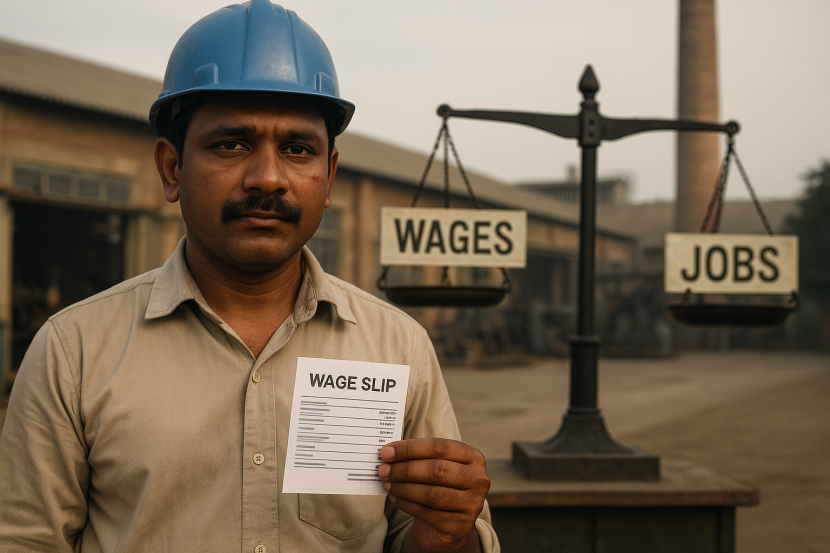Minimum wage — the lowest amount an employer must legally pay their workers — is a hot-button issue in India. With inflation, widening income gaps, and demands for improved worker welfare, discussions around minimum wage have become increasingly relevant. These debates extend beyond policy circles, influencing livelihoods, business operations, and the country’s broader economic health. One of the most debated concerns is its impact on unemployment — does increasing minimum wage reduce poverty or increase joblessness?
Understanding the Basics: Linking Minimum Wage to Labour Economics
The minimum wage ensures that workers earn a basic living standard, protecting them from exploitative wages. In India, the Code on Wages, 2019 consolidated four wage-related laws and introduced a national floor wage to simplify implementation across sectors.
Unemployment arises when people willing to work at prevailing wages cannot find jobs. In labour economics, the link between minimum wage and unemployment is complex. If set too high, employers might reduce hiring or automate tasks. If set too low, it fails to protect workers. The balance is key.
🟡 Important Fact:
India’s informal sector employs over 90% of the workforce, and many of them do not receive even the prescribed minimum wage.
Source: International Labour Organization (ILO) India Country Report
Argument For Raising the Minimum Wage
- Poverty Alleviation: Higher wages directly improve the standard of living for the lowest-paid workers.
- Boost to Consumer Spending: More disposable income can drive demand in the economy.
- Improved Morale & Productivity: Workers paid fairly are generally more motivated and productive.
- Push Toward Formalization: It can encourage better employment contracts and reduce exploitation
🟡 Important Fact:
According to the Economic Survey 2019, a 30-40% increase in minimum wage led to only a 1-2% decrease in employment, showing that the negative impact on jobs might be smaller than feared.
Argument Against Raising the Minimum Wage
- Cost Burden on Small Businesses: Especially in rural or informal sectors, higher wages may be unaffordable.
- Reduced Hiring or Job Cuts: Employers may avoid hiring or reduce hours to compensate for higher wage bills.
- Increased Informality: To bypass laws, some employers might avoid registering workers officially.
- Regional Economic Imbalance: A uniform wage policy may not suit all states due to varying living costs.
🟡 Important Fact:
States like Bihar, Jharkhand, and Chhattisgarh have lower living costs and economic capacity. Imposing high national minimum wages may hurt local job markets in these areas.
What Does the Data Say?
India’s wage scenario reveals contrasting trends:
- Over 50% of workers earn less than the minimum wage, especially in the agriculture and construction sectors.
- PLFS (2022-23) shows that unemployment among urban youth is nearly 15%, highlighting the need for more jobs alongside better pay.
- Kerala and Delhi, where higher minimum wages are in place, show less wage disparity and better compliance, yet face challenges in generating enough formal jobs.
🟢 Recommended Reading:
Balancing the Debate: A Path Forward for India
To craft effective wage policies that reduce poverty without triggering unemployment, India needs a tailored, data-driven approach:
- Regionally adjusted minimum wages, respecting cost-of-living differences.
- Phased implementation for industries to adapt gradually.
- Government support for MSMEs via wage subsidies or tax incentives.
- Digital compliance systems to monitor implementation transparently.
- Skill training and productivity programs to match wage hikes with output.
🟡 Important Fact:
The Code on Wages, 2019, proposes a “National Floor Wage” — a uniform benchmark — but allows states flexibility to go higher based on their local conditions.
Final Thought : Striking the Right Balance
India’s minimum wage debate is a balancing act between protecting workers’ rights and fostering job creation. While raising the minimum wage in India can offer a pathway out of poverty, doing so without considering regional disparities and industry limitations can backfire, pushing more workers into the shadows of informality. Effective wage reform in India must be gradual, region-sensitive, and linked to productivity improvements.
Ultimately, the goal isn’t just to create more jobs — it’s to create decent work, where every individual is paid fairly, treated with dignity, and given the opportunity to grow.




